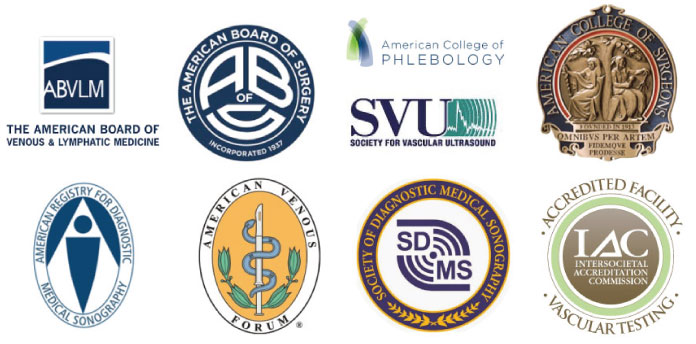Leg pain is an early symptom of chronic venous insufficiency. Pain in the legs from vein disease is often described as an aching or throbbing leg pain. As the skin becomes affected, itching and burning leg pain can develop. This pain in the legs often precedes the development of varicose veins, swelling, or skin damage.
Pain in the legs has many causes such as:
- Arthritis or other inflammatory problem
- Trauma with contusion, hematoma, or fracture
- Nerve compression
- A Baker’s cyst behind the knee
- Vascular problems such as aneurysms, malformations, fistulas
Problems with the venous system also cause pain from:
- Chronic venous insufficiency (CVI) with incompetent valves in the superficial veins, perforator veins, or deep veins
- Deep venous thrombosis (DVT)
- Superficial venous thrombophlebitis (SVT, or just phlebitis)
- Wound pain in a venous ulcer
Pain from chronic venous insufficiency is usually an early symptom, preceding the development of varicose veins, swelling, or skin problems. This pain is most commonly described as aching, but can also be throbbing or burning. It can be relieved with exercise, elevating the legs, and avoidance of prolonged sitting or standing. Anti-inflammatory medications often relieve the pain because of the inflammation that develops with constant exposure of the veins to high pressure. In evaluating patients with chronic venous insufficiency, we often characterize the pain based on its severity. Mild pain is described as occasional, not limiting activities, or requiring pain medication. Moderate pain occurs on a daily basis and produces some limitation of activity. It requires occasional use of analgesics. Severe pain occurs daily, severely restricts activity, and requires the regular use of analgesics. Pain in the presence of CVI, with some limitation of activity, constitutes a medical problem.
In deep venous thrombosis, pain is produced from the inflammation that develops in and around the clot. If the thrombus develops below the knee, there is often no associated swelling because blood has other deep veins through which to travel up toward the heart. If the thrombus develops at or above the knee, there is obstruction because a single vein carries the blood toward the heart. In addition to pain caused by inflammation in the clot, pain is also caused by the building pressure in the vein below the clot, because of the blockage. In this case, swelling usually accompanies the pain, which can become quite severe. Squeezing the calf can produce excruciating pain. This pain acquires analgesics. Sometimes it can be relieved more quickly if the clot can be dissolved by an enzyme such as urokinase or removed using a special catheter with blades that break up the clot.
Superficial venous thrombophlebitis usually starts in large varicose veins, producing a great deal of inflammation. We usually recommend that a patient with phlebitis use compression stockings and walk as much as can be tolerated. Anti-inflammatory medications are often taken for a long period of time before the pain subsides completely. Occasionally the clot expands so much that stretching of the vein wall intensifies the pain to the point that it must be removed surgically. This produces immediate relief.
Another type of pain associated with venous disease is from the ulcers that develop in the most advanced stage of CVI. As a venous wound is healing, exposed nerves can produce pain around-the-clock. Pain is really intensified during wound debridement and dressing changes. We often use topical anesthetics before such procedures. Since venous ulcers are usually easy to identify, when a patient begins care of the wound, a workup for CVI should be undertaken early in the course of treatment. This often spares the patient months, even years, of pain, because treating the diseased vein usually leads to much more rapid healing of the wound and reduces the likelihood of the wound recurring.

